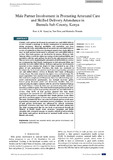| dc.contributor.author | Nyang’au, Rose A. M. | |
| dc.contributor.author | Wanzala, Maximilla | |
| dc.contributor.author | Were, Tom | |
| dc.date.accessioned | 2024-01-12T14:32:10Z | |
| dc.date.available | 2024-01-12T14:32:10Z | |
| dc.date.issued | 2021-10-14 | |
| dc.identifier.uri | https://doi.org/10.24018/ejmed.2021.3.5.978 | |
| dc.identifier.uri | https://www.ej-med.org/index.php/ejmed/article/view/978 | |
| dc.identifier.uri | http://ir-library.mmust.ac.ke:8080/xmlui/handle/123456789/2542 | |
| dc.description.abstract | Globally, male partner involvement in antenatal care and skilled delivery services remains a challenge to effective management of maternal health. Maternal morbidities and mortalities have been increasing due to the underutilization of antenatal care and skilled delivery attendance at a global level. However, developed countries have had a different story on male partner involvement in antenatal care and skilled delivery attendance – most male partners are involved in the process. But sub-Saharan Africa in the global south records the highest percentage of male partners who are never active in accompanying their female counterparts to visit antenatal care and skilled delivery. In Kenya male involvement in maternal services remains low despite it being recognized as one of the pillars of safe motherhood. Therefore, this study was conducted to investigate male partner involvement in promoting antenatal care and skilled delivery attendance in Bumula Sub-County of Bungoma County in Kenya. It focused on the level of male partners involvement in maternal health. The study adopted a cross-sectional design. The target populations were married men and community health volunteers. The study had a sample size of 427 persons. Data was collected using a pre-tested semi-structured questionnaire, key in-depth interview guides, focused group discussion guides and observation checklist. Data were analysed using descriptive statistics with the aid of the Statistical Package for Social Scientist version 25. Data were presented using tables, figures, narratives and direct quotes. The study found a low level of male involvement (18%) in promoting antenatal care and skilled delivery attendance. Most of the male partners (83.1%) did not plan with their partners for ANC and skilled delivery services, however, (54.1%) accompanied their partners to the clinics. The study concluded There was a low level of male partner involvement in ANC and skilled delivery attendance. About 18% of male partners were involvement in ANC and skilled delivery attendance. There was an improvement of male partner involvement in accompaniment and provision of support. The study recommended that the two levels of government through the Ministry of Health should create awareness campaigns and public education with a targeted massage on negative cultural practices/mindset that hinder male partner involvement in maternal health services in the Bumula sub-county. | en_US |
| dc.language.iso | en | en_US |
| dc.publisher | European Journal of Medical and Health Sciences | en_US |
| dc.subject | Male, Partner, Involvement,Promoting, Antenatal, Care, Skilled, Delivery, Attendance, | en_US |
| dc.title | Male Partner Involvement in Promoting Antenatal Care and Skilled Delivery Attendance in Bumula Sub-County, Kenya | en_US |
| dc.type | Article | en_US |

